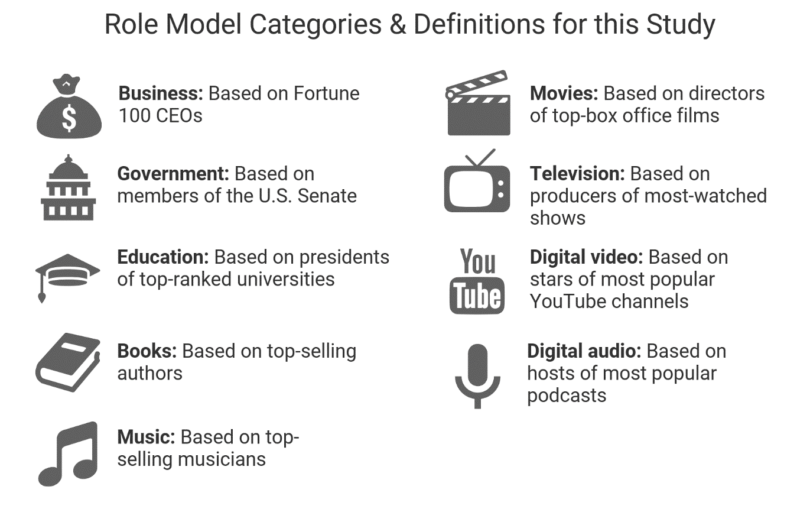Study Reveals Weak Diversity Among Key Role Models
The Benefits of a Diverse Workplace
The research is clear that diversity in the workplace is good for both employers and employees.
Many prominent studies have found proven benefits of a more diverse work environment. These benefits include an increase in innovation, reduction in turnover, a higher level of creativity, and a more effective understanding of the needs of different market segments.
The corporate bottom line is affected as well. McKinsey reports that public companies with more diverse boards have higher levels of earnings.
Many large companies have diversity programs, which include the recruitment and development of women, racial minorities, and LGBTQ individuals. Homogeneous employment settings are now considered not merely a superficial public relations problem but a business effectiveness problem.
The Importance of Role Models
While many companies strive to improve diversity in their teams, they know that delivering a diverse workforce will not happen overnight. A big driver of accelerating change is familiarity with it: change is less daunting when we are open to it.
Our role models — the people we look up to, take up media space, and earn our attention — play a key part in getting us comfortable with our differences. It is one thing to have a company with equal gender representation. It’s quite another for those in leadership roles to have equal gender representation. It is one thing for an industry to have a racially diverse workforce. It’s quite another for those who hold influential, role model positions to be racially diverse. It’s very different. So we looked into how diverse our role models are across a range of categories.
Avenue Group’s Diversity Role Model Report
We looked at the top 100 people in nine categories of influence, across business, politics, entertainment, and culture, to identify the level of diversity by both gender and race.

We compared the categories with each other, as well as with the U.S. Census, which provides a baseline for population-based gender and racial representation.
The Diversity “Baseline” is Woefully Underrepresented
Below is what the racial and gender distributions would look like across the top levels of each of the nine categories if they were in line with the distribution of the U.S. population.

The population has roughly 40 percent in racial minority groups, and a slight majority is female.
However, when we look at the results of our analysis, we see a very different story.
Below, we show the same Census data representing the U.S. population compared with the average (mean) breakdown of the top 100 across all nine categories. This highlights the stark difference in diversity between our category roles models and the general population.

There’s a noticeable shift towards both whites and men, and, not surprisingly, white men. 31 percent of the U.S. population is white and male, yet 69 percent of role models – averaged across all categories – are white males.

The Diversity Divide by Category
Although the overall picture is quite poor, there are some dramatic differences in the level of diversity across the categories that we studied. Fortune 100 CEOs are the least diverse no matter how you slice it, both by gender and by race. 95 percent of the business leaders are white, 94 percent men, and 90 percent white men.

Authors and Musicians Pave the Way…Somewhat
While best-selling authors skew white (93 percent), they are the most representative category for women (38 percent).
Top musicians have the most racially diverse breakdown. 49 percent of top performers are non-white, with 41 percent being Black. However, 86 percent of these musicians are men, making the category one of the worst gender diversity offenders.
Digital Media Most Consistently Diverse
The newer, up-and-coming digital categories are more diverse than most others in both gender and race. Both Podcast hosts and YouTube channel stars are among the top three most diverse categories (of the nine) for racial minority and female representation.
There is certainly a long way to go to improve diversity across all categories. As our role models become more diverse, those who aspire to emulate them will be more inspired and provide tangible examples of success to help them move through their career journeys.
Summary of Methodology
Data from the July 2017 U.S. Census was used. For each category, Avenue Group researchers compiled objective lists of the top 100 role models based on publicly-available metrics. Individuals on each category’s top 100 list were identified by both race and gender. We recognize that both race and gender are not as simple to categorize in the way we did, however, we did so to compile a consistent view across industries without requiring additional in-depth research. We acknowledge that the accuracy of our analysis has some limitations due to this over-simplification, yet we believe the findings remain valid and informative. In the case of multiple people sharing a place on a list (e.g., two producers for a television show), all were included.
This article was written by Avenue Group Founder Jeremy Greenberg and Avenue Group Researcher Mason Gao






Where are sports figures? That seems like an obvious category missing from the analysis?
Thanks for sharing your feedback. Good question. We did not include athletes in our research mainly because it would be tricky to choose the top 100 across so many categories. Perhaps we will consider looking at the top 100 highest paid athletes… that could be interesting.